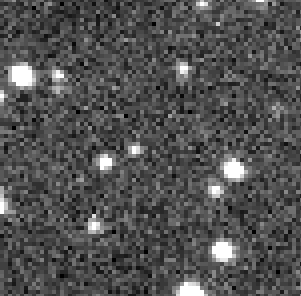
0.61-m telescope, exposure 6 x 4 minutes, magnitude of 2010 AN39 is 19.5.
2010 AN39
I have found this new asteroid 2010 January 05 with the 0.61-m telescope of the Sierra Stars Observatory (G68) with an apparent magnitude of 19.5. Follow-up observations from H11, G68 and E16 were made until January 25. The latest published orbit is on MPEC 2010-B42:
Object H G Epoch M Peri. Node Incl. e a Arc C K10A39N 15.7 0.15 K1014 15.988 140.081 286.011 6.001 0.38924 4.50712 20 X
The semimajor axis (a = 4.51) is in the "nowhere-land" between those of the Hildas (a ~ 4) and of the Jupiter Trojans (a ~ 5). The aphelion is at Q = 6.261 AU outside of the Jupiter aphelion (5.455 AU). It's a Jupiter-crosser with a small Jupiter MOID of 0.10 AU. Together with the small orbital inclination this indicates a possible cometary nature of this object. The Jupiter Tisserand is 2.87, less than 3 as expected for a comet of the Jupiter family.
I have made 300 Monte Carlo runs (using EXORB) with the available observations and found a = 4.517 ▒ 0.011 and e = 0.3908 ▒ 0.0019 indicating that this is definetely a Jupiter-crosser with Q ~ 6.28 ▒ 0.03 AU. The time of perihelion comes out as 2009 July 31.0 ▒ 3 days (when it was unobservable behind the sun).
The best images until now are from
H11 (January 25):

0.61-m telescope,
exposure 6 x 4 minutes, magnitude of 2010 AN39 is 19.5.
I have measured the full width at half maximum (FWHM) of the six stacked images of 2010 AN39 with Astrometrica as 3.1". The stacked images of stars in the vicinity of 2010 AN39 with similar SNRs have FWHMs of 3.4/3.1/3.1/2.8/3.2", no sign of a coma is visible (T3: finding comet in the asteroid population).
Maik Meyer sent to me this link of asteroids with Jupiter Tisserands <3. There are about 655 of them, but only few similar to 2010 AN39. I looked for candidates at the previous perihelion of 2010 AN39 and found 1999 XN120. But this is really not an asteroid but a periodic comet (P/1999 XN_120 (CATALINA) IAUC 7370)! The orbital elements of 2010 AN39 and 1999 XN120 are similar but an identity of both objects isn't possible.
| Designation | a | e | q | Q | peri | node | incl | P | Source |
| P/1999 XN120 | 4.19 | 0.21 | 3.30 | 5.07 | 161.6 | 285.4 | 5.0 | 8.57 | MPC 54170 |
| 2010 AN39 | 4.51 | 0.39 | 2.75 | 6.26 | 140.1 | 286.0 | 6.0 | 9.57 | MPEC 2010-B42 |
I have extracted all asteroids
from the list with Jupiter Tisserands <3 with following
properties:
aphelion between Jupiter aphelion and Saturn perihelion (5.455
< Q < 9.008)
perihelion inside Jupiter's orbit (q < 4.95 )
orbital inclination less than 20 degree
Jupiter MOID less than 0.2 AU (the MOIDs were taken from this list
at the Lowell site)
observed arc greater than 10 days.
There are 30 asteroids with these
properties (27 of them were found during the last ten years).
First found was 6144 Kondojiro (1994 EQ3) on 1994 March 14 with
mag 16.5 (MPEC 1994-G05). Two other asteroids are numbered: 145485 (2005
UN398) and 228862 (2003 GX31). Another six have been observed in
more than one opposition.
| Name | H | Arc(d) | Arc(y) | a | e | i | q | Q | TJ | JMOID |
| 1994 EQ3 | 11.5 | 20031 | 56 | 4.781 | 0.359 | 5.86 | 3.065 | 6.497 | 2.868 | 0.19054 |
| 1995 WL3 | 19.0 | 64 | 1 | 4.475 | 0.627 | 18.92 | 1.668 | 7.281 | 2.529 | 0.13923 |
| 1996 RR10 | 16.4 | 13 | 1 | 3.839 | 0.422 | 3.24 | 2.220 | 5.457 | 2.911 | 0.12736 |
| 2000 BK2 | 16.7 | 77 | 1 | 3.636 | 0.536 | 7.03 | 1.687 | 5.585 | 2.832 | 0.19761 |
| 2000 CA13 | 17.6 | 2564 | 8 | 3.749 | 0.556 | 1.45 | 1.663 | 5.834 | 2.798 | 0.13833 |
| 2000 XO8 | 15.5 | 72 | 1 | 4.233 | 0.654 | 12.21 | 1.463 | 7.003 | 2.562 | 0.00675 |
| 2001 QG288 | 16.1 | 3013 | 9 | 4.070 | 0.428 | 3.99 | 2.329 | 5.811 | 2.873 | 0.09905 |
| 2002 EV71 | 14.6 | 2837 | 9 | 4.276 | 0.313 | 10.95 | 2.936 | 5.616 | 2.907 | 0.03673 |
| 2002 RQ28 | 18.4 | 42 | 1 | 3.735 | 0.563 | 9.31 | 1.632 | 5.839 | 2.775 | 0.03713 |
| 2002 UP36 | 17.1 | 69 | 1 | 3.944 | 0.444 | 1.35 | 2.194 | 5.695 | 2.879 | 0.03303 |
| 2003 BM1 | 18.3 | 56 | 1 | 3.678 | 0.503 | 11.21 | 1.828 | 5.527 | 2.84 | 0.1483 |
| 2003 BU35 | 16.4 | 2614 | 8 | 3.742 | 0.537 | 14.87 | 1.734 | 5.751 | 2.774 | 0.19604 |
| 2003 GX31 | 13.9 | 2896 | 9 | 4.468 | 0.225 | 10.74 | 3.461 | 5.474 | 2.939 | 0.11427 |
| 2004 AE9 | 17.4 | 89 | 1 | 5.109 | 0.644 | 1.65 | 1.818 | 8.401 | 2.534 | 0.06595 |
| 2005 NK61 | 16.5 | 124 | 1 | 4.322 | 0.418 | 5.80 | 2.513 | 6.130 | 2.851 | 0.0923 |
| 2005 TS100 | 13.7 | 4766 | 14 | 5.560 | 0.165 | 8.55 | 4.642 | 6.478 | 2.952 | 0.05124 |
| 2005 UN398 | 13.8 | 8241 | 24 | 4.606 | 0.518 | 11.57 | 2.218 | 6.993 | 2.706 | 0.07955 |
| 2006 SV301 | 14.2 | 4430 | 13 | 5.105 | 0.495 | 5.31 | 2.576 | 7.633 | 2.733 | 0.17032 |
| 2006 UE63 | 19.8 | 37 | 1 | 4.294 | 0.629 | 6.21 | 1.591 | 6.996 | 2.615 | 0.06567 |
| 2006 UF255 | 16.6 | 31 | 1 | 4.468 | 0.312 | 6.44 | 3.072 | 5.863 | 2.914 | 0.16394 |
| 2006 XL5 | 16.8 | 126 | 1 | 3.729 | 0.513 | 4.52 | 1.817 | 5.642 | 2.844 | 0.15825 |
| 2007 TB374 | 15.1 | 30 | 1 | 4.366 | 0.362 | 13.40 | 2.784 | 5.948 | 2.853 | 0.13901 |
| 2008 RC125 | 14.6 | 31 | 1 | 5.404 | 0.192 | 11.48 | 4.365 | 6.443 | 2.923 | 0.10503 |
| 2008 SW117 | 16.6 | 34 | 1 | 4.427 | 0.371 | 4.30 | 2.786 | 6.067 | 2.884 | 0.14333 |
| 2008 SZ276 | 14.2 | 39 | 1 | 5.527 | 0.182 | 7.24 | 4.520 | 6.534 | 2.952 | 0.02037 |
| 2008 SZ283 | 17.2 | 47 | 1 | 3.961 | 0.417 | 14.8 | 2.308 | 5.613 | 2.847 | 0.10334 |
| 2008 WZ96 | 14.5 | 28 | 1 | 3.573 | 0.535 | 6.99 | 1.659 | 5.486 | 2.846 | 0.0559 |
| 2009 SK319 | 14.0 | 24 | 1 | 5.496 | 0.105 | 3.89 | 4.920 | 6.073 | 2.986 | 0.02663 |
| 2009 SL137 | 16.9 | 14 | 1 | 4.612 | 0.541 | 0.46 | 2.115 | 7.110 | 2.711 | 0.05418 |
| 2010 AN39 | 15.7 | 20 | 1 | 4.507 | 0.389 | 6.00 | 2.753 | 6.261 | 2.859 | 0.10420 |
How common is it that objects first classified as asteroids later become periodic comets?
The Periodic Comet Names List has 71 entries with names derived from asteroidal designations. 31 of them are numbered periodic comets, 65 comets have designations from 1998 to 2009.
Rainer Kracht, 2010 February 11
NEWS
12.02.2010 With additional observations from Rigel (657) I could extend the observed arc of 2010 AN39 from 20 to 35 days.
14.02.2010 The
Daily Orbit Update (MPEC 2010-C53) has a multi-oppositions orbit
for 2010 AN39 with additional observations in 2008.
Spacewatch II (291) observed 2010 AN39 on 2010 February 13 (291
is the observatory code of the 1.8-meter telescope), but no
cometary feature was detected.
10.04.2010 WISE (C51) made ten observations 2010 AN39 on 2010 March 29 and 30. Apparently no cometary activity was detected. Perhaps a stack of these images will show something.
| Name | H | Arc(d) | Arc(y) | a | e | i | q | Q | TJ | JMOID |
| 2010 AN39 | 15.5 | 547 | 2 | 4.500 | 0.388 | 5.97 | 2.756 | 6.243 | 2.862 | 0.11252 |
25.04.2011 The WISE Preliminary Data Release has been published, 2010 AN39 looks stellar:
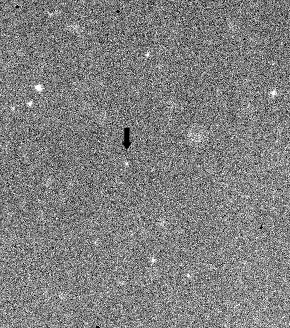
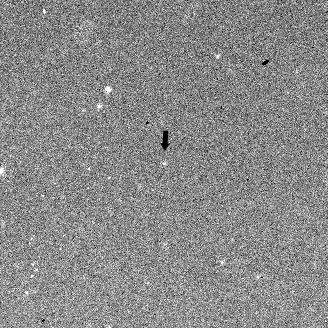
WISE 12 Ám 2010 March 29
07:20:19 (left) and 10:30:50 (right) UTC
WISE has taken 15 images of 2010 AN39 but only 10 have been measured. I have added twelve images (12 Ám) with ImageJ and enlarged two times:
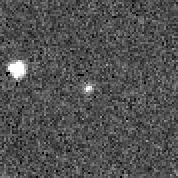
I have also added twelve images from the 22 Ám band and enlarged four times:
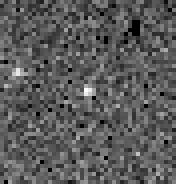
The asteroid is now brighter than the star at the left border, but again no cometary activity is visible.
2017: F51 – Pan-STARRS 1 (1.8-meter telescope) observed 2010 AN39 on five nights from July 05 to Aug 19.
2018/2019: 2010 AN39 was observed on 17 nights from 2018 Sep 09 to 2019 Jan 04 (perihelion was on 2019 Mar 02).
18.05.2019 2010 AN39 has been numbered 529456 (MPC 114667).
2019/2020: 529456 was observed on 12 nights from 2019 Nov 08 to 2020 Mar 22.
15.03.2021 529456 was observed by F51 – Pan-STARRS 1.
Rainer Kracht, 2021 August 07